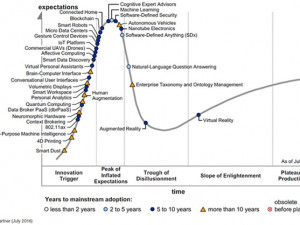Transparently immersive experiences, smart machines and the platform revolution are trends CIOs should have on their watch lists, says Gartner.
If adopted now, these technologies will deliver competitive advantage and accelerate digital business innovation over the next five to 10 years, says the consultancy firm.
To help business leaders discern what emerging technologies will be commercially viable, each year the Gartner Hype Cycle plots new technologies on a hype graph and highlights trends.
The firm says business strategists, chief innovation officers, R&D leaders, entrepreneurs, global market developers and emerging-technology teams should be looking towards implementing certain technologies within these trends that best fit their organisations.
Transparently immersive experiences incorporates technologies like augmented reality (AR), virtual reality (VR), brain-computer interface, human augmentation, the connected home, nanotube electronics and gesture-controlled devices.
Gartner says technology will become increasingly human-centric, to which transparency between people, businesses and things will be introduced.
The firm says customers will expect businesses to interact with them on their smartphones and other devices, and to be offered unique experiences.
The second trend ? smart machine technologies ? will be the most disruptive over the next 10 years, because organisations with these technologies will be able to harness data to adapt to new situations and solve problems that no one has encountered previously.
Factors that have aided the advancement of smart machine technologies are huge amounts of data, increased computational power and advances in deep neural networks.
The emerging technologies that fall under this trend include virtual personal assistants, smart robots, drones, autonomous vehicles and natural-language questions.
The third trend ? the platform revolution - is how traditional business platforms will be, and are being, disrupted by technology. For example, Uber disrupted the taxi industry by providing a technology platform for drivers and passengers to connect.
"The shift from technical infrastructure to ecosystem-enabling platforms is laying the foundations for entirely new business models that are forming the bridge between humans and technology," says Gartner.
Technologies in this trend include the Internet of things, quantum computing and blockchain.
Nearly real
This year's graph shows VR is rising up the "slope of enlightenment" as headsets become more mainstream and accessible content is created. AR is entering the "trough of disillusionment" as developers continue to find uses for it beyond gaming and gimmicks.
Gartner expects both VR and AR to reach mainstream adoption in five to 10 years.
Machine learning is at the peak of inflated expectations this year and Gartner expects two to five years until widespread adoption.
4D printing and 'Smart Dust' have only just entered the hype cycle and the firm predicts it will be more than 10 years before either reach everyday application. 4D printing is 3D printing that incorporates time as a fourth dimension. This means objects will be printed in a certain shape and change or self-assemble over time.
Smart Dust is a system of many tiny microelectromechanical systems such as sensors and robots that can detect light, temperature, vibration, magnetism, or chemicals.
Plan ahead
"The Hype Cycle for Emerging Technologies... distils insights from more than 2 000 technologies into a succinct set of must-know emerging technologies and trends that will have the single greatest impact on an organisation's strategic planning," says Mike Walker, research director at Gartner.
There are five phases in the emerging technologies hype cycle: the technology trigger, the peak of inflated expectations, the trough of disillusionment, the slope of enlightenment, and the plateau of productivity.
"To thrive in the digital economy, enterprise architects must continue to work with their CIOs and business leaders to proactively discover emerging technologies that will enable transformational business models for competitive advantage, maximise value through reduction of operating costs, and overcome legal and regulatory hurdles," says Walker.
"This Hype Cycle provides a high-level view of important emerging trends that organisations must track, as well as the specific technologies that must be monitored."

Share